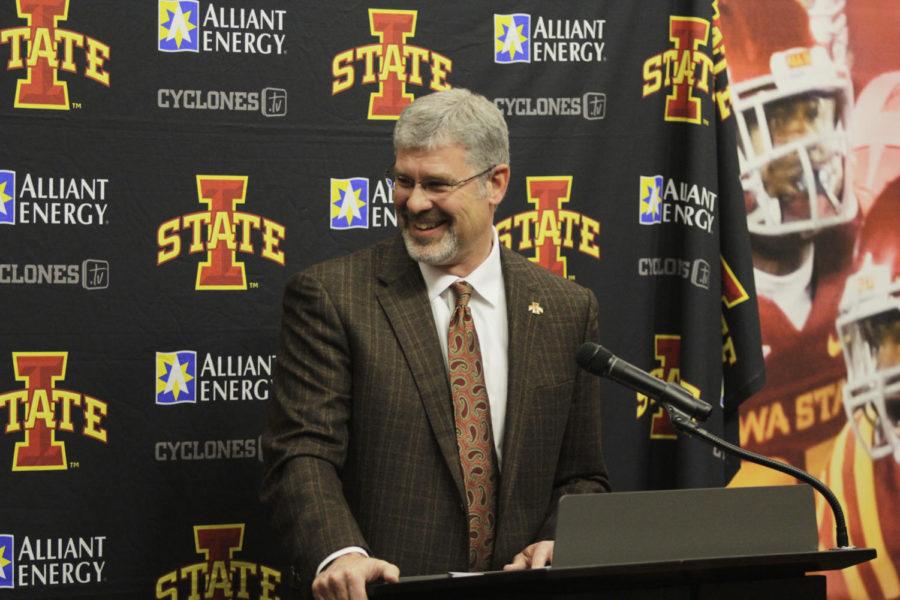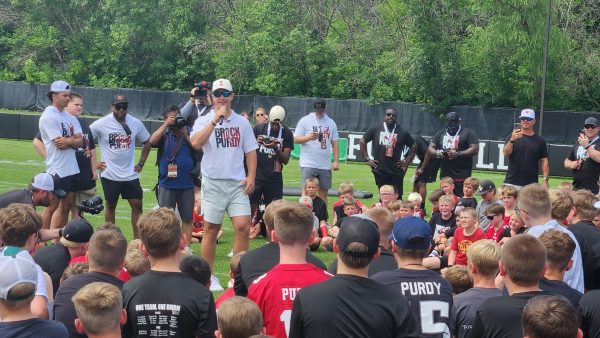Big 12 Media Days: Rhoads looks to 2014, comments on player safety
Kelby Wingert/Iowa State Daily
ISU coach Paul Rhoads jokes with the media about the power of JUCO recruit Jordan Harris to “knock people’s fillings loose” during the National Signing Day press conference Feb. 5.
July 23, 2014
The 2013 football season ended well for Iowa State, as it finished on a two-game win streak against Kansas and West Virginia after losing seven straight games in the Big 12.
In 12 days, a new season will start for the Cyclones, with a little bit of emphasis on the new.
In the off-season, coach Paul Rhoads brought in six new coaches, including Mark Mangino, who most notably led Kansas to an Orange Bowl victory in 2007.
“I reached out to him and certainly had great respect for what he’s done in our profession,” Rhoads said July 22 at Big 12 Media Days.
After leaving Kansas in 2009, Mangino worked as an assitant at Youngstown State, his alma mater.
“I also know that he was anxious to get back to this level,” Rhoads said. “He wasn’t just going to jump back in at any job. He saw an opportunity for success at our place.”
Joining Mangino as a first year ISU athlete is incoming freshman wide receiver Allen Lazard. Lazard, an Urbandale, Iowa, native, was ranked as the No. 47 prospect in the 2014 class by Rivals.com.
As a high school senior, Lazard impressed scouts by catching 46 passes for 1,065 yards and 16 touchdowns. Rhoads said that Lazard has continued to impress this summer.
“He came in and did a great job with our summer weight program this year, maybe even above our expectations as a coaching staff,” Rhoads said. “He’s going to get his reps, he’s going to get his opportunities to catch balls.”
Players like tight end E.J. Bibbs, running back Aaron Wimberly and center Tom Farniok will serve as anchors on an experienced offense.
Farniok will look to lead an offensive line that cycled through 10 different starters last season, while Bibbs and Wimberly will act as weapons for whichever quarterback Rhoads decides to play, a decision he said he hopes to make by Aug. 16, if not before.
For Bibbs, who was 13th in the nation last season in catches with 39, the offseason has been exciting one. The junior college transfer was named to the Mackey Award watch list and was a preseason first team All-Big 12 selection.
“It’s an honor,” Bibbs said. “I really appreciate all of the awards and I can’t wait for the season coming up.”
Safety First
On July 7, the NCAA released new guidelines for concussion safety, which include limiting the number of full-contact football practices.
The guidelines call for four live contact practices per week in the preseason, with a maximum of 12. During the season and postseason, the guidelines call for no more than two live practices per week.
At Big 12 Media Days on July 21 and 22, coaches throughout the conference fielded questions about player safety and limiting contact.
“I’m certainly in favor of anything that aids in player safety and the research and everything that goes behind that,” Rhoads said.
Gary Patterson, head coach at Texas Christian, said that most coaches already follow the sort of guidelines that the NCAA is suggesting.
“I think there’s a lot of us already doing it the right way anyhow,” Patterson said. “I think coaches want to protect their players. It’s as simple as that. You’ve got to get your best players to Saturdays, so I don’t think media or a lot of people give us enough credit for what we do try to accomplish to protect our young people.”
The safety guidelines are not rules. Rather, they are recommendations to reduce concussions and other injuries. Currently, the Ivy League and Pac-12 are the only conferences with rules where live hitting and contact is concerned.
A point of concern among some coaches like Rhoads and Kansas coach Charlie Weis is what role limiting contact will play in developing younger players.
“I don’t think anyone pounds their guys that play all the time every week all the time. I don’t think that happens with anybody,” Weis said. “I think that the only gray area is going to come into the fact that how do you get your young guys prepared to play if they’re not getting any of the real reps when you’re getting ready to play your game.”

















